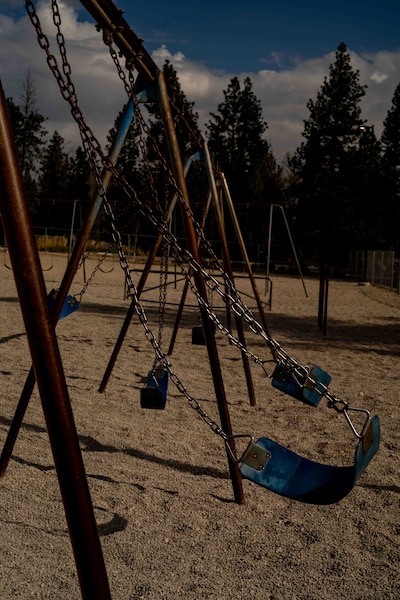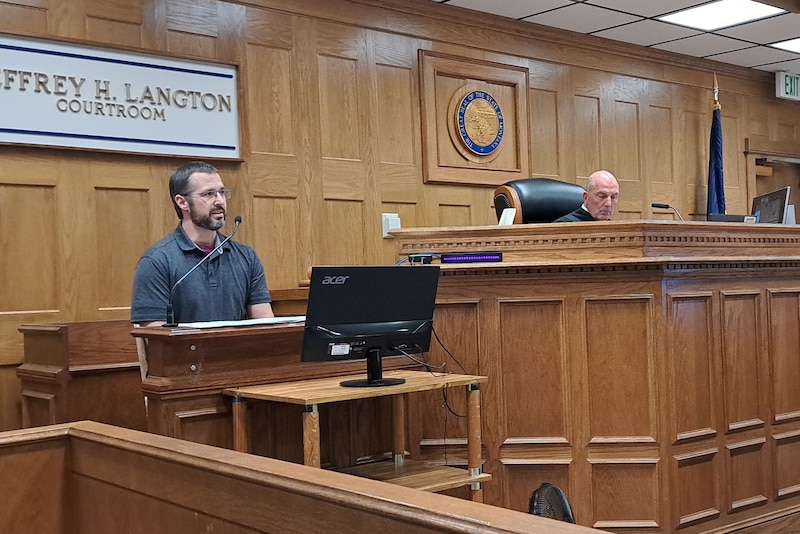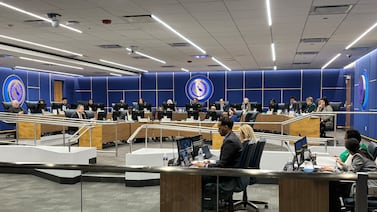This story about the four-day school week was produced by The Hechinger Report, a nonprofit, independent news organization focused on inequality and innovation in education. Sign up for the Hechinger newsletter.
RAVALLI COUNTY, Mont. — After years of putting it off, Montana’s Florence-Carlton school district had to decide: Would it join the many smaller districts in the state with a four-day school week, or stick with a five-day schedule?
Until recently, some local education leaders thought the four-day week was a poor fit for the town of Florence. Staffing problems, including having to cut nine employees, the end of pandemic-era education funding, and the loss of 50 students this school year, however, put the district of about 730 students in a tight spot.
Florence, a rural town in the southwestern part of the state 30 minutes from two districts that pay their teachers more, has dealt with staffing gaps that left positions near impossible to fill. Last school year, the high school principal ended up teaching some classes after a job posting for a math teacher received no applications for a semester and a science teacher left for a better paying job nearby. A paraprofessional job has remained open the entire school year, Florence-Carlton Superintendent Todd Fiske said.
A four-day school week might be a tool to recruit and retain staff, the school board reasoned, while offering families more time together.
A community survey showing that of parents and community members who responded, 51% favored a shift to a four-day school week. The five-person board approved the model 3-to-1 in January, with one abstention. Starting this fall, the school day will be lengthened by 45 minutes, and schools will be closed on Fridays.
Related: A lot goes on in classrooms from kindergarten to high school. Keep up with Hechinger Report’s free weekly newsletter on K-12 education.
While most such shifts across other Montana districts have been made with little opposition, in Florence, pushback was fierce.
There were standing-room-only public meetings with community members threatening not to support future budget levies. Parents filed two formal complaints. One family sued. Some are transferring their children to districts miles away next year or will take on homeschooling out of concern their kids would otherwise fall behind.
Some board members were taken aback. “Ninety-nine percent of the people in this room have not been to a meeting that I’ve seen,” board chair Matthew Roth, who voted against the change, told a crowded public meeting in March. “Only when this comes up, people are showing up.”
The rift in the community exposes a larger divide and uncertainty around the four-day school week, even as districts in Montana and across the country continue to march toward it. Nearly 40% of Montana districts have students attend school four days a week and about 80% of the state’s counties have at least one school operating on that schedule. In 2022 and 2023, 32 districts in the state adopted the model.

Nationwide, the number of four-day districts in the U.S. is approaching 900 in 26 states; the model picked up steam after the pandemic. Districts continue to consider it a solution for addressing staffing shortages and financial challenges.
In Florence, located in a valley between a pair of mountain ranges, parent Jason Breckenridge was the one who sued to stop the change, saying he was worried his kids would be “guinea pigs.” He felt the school district disregarded negative aspects of the shortened week. Virginia Mahn, a Florence-Carlton parent and graduate, brought a complaint against the school board, alleging district leaders failed to meet their required responsibility of ensuring a quality education.
“The only things they showed as positives were anecdotal,” Mahn said. “It’d be an article from a superintendent that was like, ‘This is great for us.’ OK, so where’s your data?”
Academic achievement suffers under 4-day model
Montana first allowed the four-day school week in 2005, replacing a requirement for a 180-day school year with a 1,080-hour minimum to allow for “greater flexibility in the school calendar.” A three-part study from the University of Montana painted a grim picture of the four-day school week’s outcomes for both students and their schools.
Based on student testing data from 2008 to 2023, the study found that student learning suffered in the four-day school week. At the elementary level, reading proficiency was lower in the four-day districts by as much as 7 percentage points. For math proficiency, it was a difference of up to 14 percentage points. Including one-room schoolhouses, only 11 of the 141 four-day districts examined performed above the state averages or were improving academically.
The Montana Office of Public Instruction commissioned the study after the state saw a surge in four-day school weeks post-Covid and gave researchers access to data going back to when Montana schools first started making the switch. It’s not just Montana: Four-day school weeks are growing across the nation, as is other research that also shows negatives in academic outcomes.
“When I look at the news reporting and schools [that] are considering the four-day, there’s all these reasons, pros and cons,” said Bill McCaw, one of the authors of the study. “Student achievement is never part of the conversation. Day care, convenience, longer vacation — all that’s being discussed. But not student achievement.”
Related: Seven new studies on the impact of a four-day school week
The Montana researchers also compared costs of the four-day school week and found them to be higher, as teacher salaries and payments for other services, like transportation, often remain the same or rise. Teacher retention was also higher under the five-day model — the researchers did not speculate why, but the districts that offer four-day weeks tend to be smaller; larger districts may offer more opportunities and professional growth, even without a three-day weekend.
The one clear positive for the four-day school week? Recruitment. When surveyed, more than 80% of new teachers preferred a shortened school week over a five-day week. Montana has the highest percentage of rural schools of any state in the nation, at 75%, and the largest number of one-room schoolhouses. That translates to many small schools struggling to attract teachers.
4-day school week model continues to expand
That study wasn’t the first to show declining academic results in Montana.
In 2014, Tim Tharp, then a doctoral student at the University of Montana, assembled academic results of all of the state’s schools from 2006, when the four-day school week was first adopted, to 2013. He found that students in four-day schools had lower test scores than peers who attended school five days a week.
“If you look back at it logically, it only makes sense,” said Tharp, now the chair of the Montana Board of Public Education and Richland County’s superintendent of schools. “After a certain period of time, you’re losing days, weeks, months of instruction over the course of years.”
In the decade that’s passed, the number of Montana school districts that adopted the four-day week has nearly tripled. Tharp describes its adoption as a “race to the minimum” as schools adjust calendars to reach state-mandated hours, sometimes down to the minutes. UM’s latest study has served to deepen Tharp’s conviction, supporting his earlier research findings and emboldening him to speak more pointedly about his belief that the four-day model has not proven successful in Montana.
“Personally, the absolute best thing would be for the students to not only go 180 days, but [for the districts to] even consider making it longer,” Tharp said.
Related: What will it take for rural districts to compete with larger, better-resourced schools?
Tharp concedes his opinion is unpopular among friends and colleagues. Even in his own Richland County, 12 of 15 public schools operate on the four-day model.
Although the UM researchers recommended revising state law to again mandate 180 days, no lawmakers sponsored such a bill this year. That means no changes are possible until the Legislature convenes again in two years.
“It is going to take a lot of intestinal fortitude from the Legislature to stand up and say: ‘No, this is what’s best for kids,’” Tharp said.
Without a change in state law, researchers see districts as trapped in the four-day model. Only one Montana school district has reverted to a five-day calendar, according to their research.
“We know, anecdotally, there are districts that want to, but in order to do so, you’re going to have your teachers wanting to be paid more,” said John Matt, one of the authors of the recent UM study. “That’s a 25% increase in days. They’re not going to want to work more hours for the same salary.”
Related: Teacher licensing rules are one reason small schools don’t have enough teachers
Some states are trying to reduce or eliminate the adoption of four-day weeks. In Idaho, where two-thirds of public schools operate on the model, the state education board will begin requiring 152 instructional days in addition to mandated hours next school year. Idaho Superintendent of Public Instruction Debbie Critchfield has said she has been an opponent of the four-day model for years.
In New Mexico, home to some of the nation’s first four-day schools, the state education department tried in 2024 to require 180 days of school, with the governor voicing support for it as a way to counter persistent low academic scores. The new rule was struck down, though, after the state superintendents’ association said the new policy didn’t allow local flexibility. The case is still moving through the court system.

In Florence, Jason Breckenridge felt his only recourse was to sue the district to stop the change. Breckenridge spent part of a sunny spring break in a wood-paneled courtroom. He alleged the school board and district didn’t follow public process and acted in bad faith as they moved to the four-day model, with little certainty as to how the district would fully implement it.
“It was the only way we could get them to answer for the way the schools went about it,” Breckenridge said.
The next question: What happens on the fifth day?
Following the vote, school board chair Roth explained his abstention from the four-day week decision by saying he thought the board was “cramming this down our throat in record time” without enough consideration for what he called ripple effects. He later defended the adoption process in court.
A county judge ultimately ruled for the district, saying trustees ensured adequate notice and allowed sufficient public participation.
While Breckenridge doesn’t regret the lawsuit, he’s still unsure exactly what the next school year will look like. He has put off starting his 4-year-old in kindergarten next year. Another son will attend school in the town of Stevensville, 10 miles away from Florence, where class is in session five days a week, and his daughter will be homeschooled. It will be his family’s first time trying homeschooling.
It’s an uncertain path, said Breckenridge’s wife Megan, but one the family feels is necessary. “We have three school-aged children with very different needs,” she said.
Related: Rural schools have a teacher shortage. Why don’t people who live there teach there?
Mahn, who filed a complaint against the board, didn’t succeed in getting policy paused either. Now, she’s among the parents trying to figure out what the fifth day of the week will look like, when schools will be closed. Some Montana districts, like nearby Victor, provide in-district day care, while others collaborate with community organizations to meet the need for child care. Florence’s school board has taken no action to address the gaps created by the removal of a fifth day.
Mahn’s dad, a pastor at Florence-Carlton Community Church, is working on providing his church’s space for child care next school year. Mahn bought a curriculum to supplement her kids’ education, with her mother helping to provide instruction to her children on Fridays.
“I parceled out the pros and cons and it’s like, what am I most worried about? It’s not so much the longer days. It’s not so much that Friday off and I’ll have to pay for day care. But it’s more like the whole purpose of this school is their education,” Mahn said. “That’s what I’m most worried about.”
Contact editor Nirvi Shah at 212-678-3445, securely on Signal at NirviShah.14 or via email at shah@hechingerreport.org.
This story about the four-day school week was produced by The Hechinger Report, a nonprofit, independent news organization focused on inequality and innovation in education. Sign up for the Hechinger newsletter.






